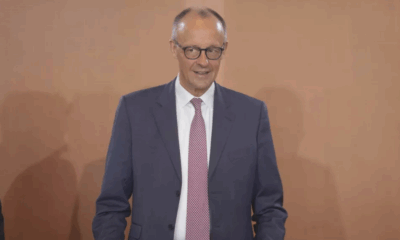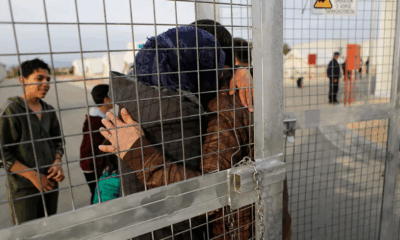News
False Claims of Ballot Manipulation Spread During 2025 German Elections
False claims regarding ballot manipulation surged on social media during the 2025 German federal elections, raising concerns over the rapid spread of misinformation and the challenges of combating fake news online. Officials and experts warn that such disinformation campaigns could significantly impact public trust in the electoral process.
Misinformation Surge in Europe
Misinformation is not exclusive to Germany. Globally, disinformation campaigns have intensified, affecting political landscapes in various countries. In the U.S., figures like former President Donald Trump and Tesla CEO Elon Musk have been associated with controversial and misleading claims. Similarly, Europe has been grappling with a persistent wave of fake news that threatens democratic institutions and public discourse.
A prime example of such false narratives emerged during Germany’s recent elections when misleading social media posts alleged that ballots in Leipzig omitted the name of the far-right Alternative for Germany (AfD) candidate. However, local officials swiftly debunked these claims, confirming that all ballots were printed uniformly, making such manipulations impossible.
How to Spot and Combat Misinformation
Experts emphasize the need for increased media literacy and critical thinking to navigate the digital landscape. EuroVerify consulted media specialists who provided key strategies for identifying and avoiding misinformation online.
1. Recognizing Red Flag Phrases
According to Marc Owen Jones, professor of media analytics at Northwestern University in Qatar, certain stock phrases are strong indicators of misleading content. Expressions like “Western media isn’t telling you” or “mainstream media is hiding this” often signal misinformation, particularly during major events such as elections or conflicts.
Robert Rajczyk, professor at the Institute of Journalism and Media Communication at the University of Silesia in Katowice, warns that social media algorithms exacerbate this issue by amplifying controversial content. He notes that platforms curate content based on user preferences, often reinforcing preexisting biases and deepening societal polarization.
2. Identifying AI-Generated Misinformation
The rise of artificial intelligence (AI) in content creation has made it increasingly difficult to distinguish between real and fake information. Jones explains that AI-generated images and deepfakes often exhibit subtle inconsistencies, such as asymmetrical facial features or misplaced accessories like earrings and glasses stems. While not foolproof, closely examining such anomalies can help detect manipulated content.
Jones further highlights that AI-driven misinformation is particularly dangerous because it plays on users’ emotions, making them more likely to share false information without verification. The virality of such content fuels the rapid spread of disinformation.
3. Verifying Sources and Promoting Media Literacy
Fact-checking remains a critical tool in combating misinformation. Ike Picone, professor of media and journalism studies at the Vrije Universiteit Brussel, stresses the importance of understanding how news production works. Recognizing potential biases in traditional media and cross-referencing multiple reputable sources can help individuals make informed judgments about the credibility of news.
Rajczyk echoes this sentiment, emphasizing the need to consume news from diverse mainstream sources to gain a balanced perspective. He warns that a lack of historical and contextual knowledge makes individuals more susceptible to false narratives.
The Importance of Vigilance
As digital misinformation continues to evolve, staying informed and critical of online content is more crucial than ever. By developing media literacy skills, questioning suspicious claims, and relying on credible news sources, internet users can play a proactive role in combating the spread of fake news and preserving the integrity of democratic processes.
News
Two Dead, Nearly 200 Injured as PSG Title Celebrations Turn Violent Across France

What began as jubilant celebrations of Paris Saint-Germain’s historic UEFA Champions League victory ended in violence and tragedy in parts of France, with two people killed and nearly 200 injured during street festivities that spiraled out of control.
Authorities confirmed on Sunday that a 17-year-old boy was fatally stabbed in the southwestern town of Dax during a PSG street gathering, while in Paris, a man died after his scooter was struck by a car amid the crowded celebrations. Both incidents are currently under investigation.
The unrest followed PSG’s dramatic win in Munich, where the club secured its first-ever Champions League title, marking a milestone in French football history. While fans across the country took to the streets to celebrate, several areas descended into violence.
According to the French Interior Ministry, a total of 294 people were arrested nationwide as of 2 a.m. Sunday. Of the nearly 200 injured, 21 were police officers—18 of them in Paris alone. One officer remains in a medically induced coma after being struck in the face by a firework.
Interior Minister Bruno Retailleau condemned the violence in a statement on social media. “True PSG fans are celebrating a magnificent achievement. Meanwhile, barbarians have taken to the streets to commit crimes and provoke law enforcement,” he said. “It is unacceptable that people cannot celebrate without being endangered by a violent minority.”
Despite the unrest, the majority of gatherings were peaceful, authorities noted, with large crowds celebrating the historic win in cities including Marseille, Lyon, and Lille.
The PSG squad returned to Paris from Munich on Sunday afternoon aboard a Qatar Airways charter flight, arriving at 4 p.m. The team is expected to continue celebrations in the capital with tens of thousands of fans, under heightened security measures.
The violent turn of events has reignited debate in France over crowd control during major sporting celebrations, and how best to ensure public safety without dampening national enthusiasm.
PSG’s Champions League triumph marks a defining moment for the club, which has long pursued European glory. As the team prepares for a hero’s welcome, officials are urging fans to celebrate responsibly and respect public safety.
News
Ukraine Launches Major Drone Assault on Russian Airfields, Hits Over 40 Strategic Bombers

Ukraine’s Security Service (SBU) has claimed responsibility for a large-scale drone strike on four Russian air bases over the weekend, targeting dozens of strategic bombers across vast swaths of Russian territory — from Siberia to the Arctic.
According to Ukrainian officials, the operation, codenamed “Spiderweb” (Pavutyna), was launched on June 1 and struck 41 long-range bombers stationed at airfields in Russia’s Ryazan, Ivanovo, Irkutsk, and Murmansk regions. The attack is being hailed by Kyiv as one of its most ambitious and far-reaching strikes since the beginning of Russia’s full-scale invasion.
“Enemy strategic bombers are burning en masse in Russia,” a senior SBU official said, noting that the operation was specifically designed to cripple Moscow’s airstrike capabilities. “This is a large-scale special operation aimed at destroying enemy bomber aircraft.”
The four airfields targeted were Dyagilevo in the Ryazan region, Ivanovo in central Russia, Belaya air base in Irkutsk — over 4,000 kilometers from the front lines — and Olenya air base on the Kola Peninsula near the Arctic, roughly 2,000 kilometers from Ukraine’s border.
Ukrainian officials described the complex logistics of the operation, which involved covertly transporting drones deep into Russian territory, hiding them until the time of launch, and remotely executing the strikes. While specific details remain classified, Ukraine previously revealed it had developed drones with a flight range of up to 3,000 kilometers, enabling long-range operations like this.
Satellite imagery analyzed after the attack shows the presence of several high-value Russian aircraft types at the affected bases, including the Tu-95, Tu-22M3, Tu-160, and A-50 radar planes. These aircraft have been central to Russia’s long-range missile campaign against Ukraine.
The Tu-22M3, for example, is capable of carrying Kh-22 and Kh-32 cruise missiles at speeds exceeding Mach 4. The Tu-95, a Cold War-era bomber once designed to carry nuclear weapons, has been retrofitted to launch conventional cruise missiles. The A-50 aircraft provides airborne radar surveillance and target coordination for Russian forces.
The scale of the strike underscores Ukraine’s growing long-range capabilities and signals a shift in Kyiv’s strategy to disrupt Russian air operations at their source. President Volodymyr Zelenskyy said he had held meetings with the Ministries of Defense and Foreign Affairs, along with the General Staff and SBU, to coordinate further defense and counter-offensive planning.
There has been no immediate official response from Moscow regarding the extent of damage caused.
News
German Chancellor Merz to Meet President Trump in Washington Amid Global Tensions
-

 Business1 year ago
Business1 year agoSaudi Arabia’s Model for Sustainable Aviation Practices
-

 Business1 year ago
Business1 year agoRecent Developments in Small Business Taxes
-

 Politics1 year ago
Politics1 year agoWho was Ebrahim Raisi and his status in Iranian Politics?
-

 Business11 months ago
Business11 months agoCarrectly: Revolutionizing Car Care in Chicago
-

 Business11 months ago
Business11 months agoSaudi Arabia: Foreign Direct Investment Rises by 5.6% in Q1
-

 Technology1 year ago
Technology1 year agoComparing Apple Vision Pro and Meta Quest 3
-

 Politics1 year ago
Politics1 year agoIndonesia and Malaysia Call for Israel’s Compliance with ICJ Ruling on Gaza Offensive
-

 Sports10 months ago
Sports10 months agoKeely Hodgkinson Wins Britain’s First Athletics Gold at Paris Olympics in 800m






























